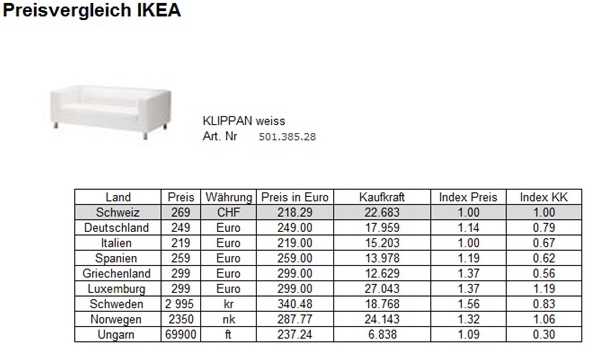Author: Livria Laurent
International companies use different price points for identical products. Basically, such an approach is feasible as buying power is different among countries. However, the price comparison analysis of the sofa KLIPPAN from retailer IKEA, shows a very different picture.

Surprisingly, the sofa KLIPPAN can be bought in Switzerland for EUR 218.00, the lowest price of all countries involved in the analysis. By having a look at the statistics, it shows that Norway’s buying power is 6% higher than in Switzerland, yet a Norwegian customer has to pay 32% more for the same sofa.
IKEA is not only market leader in the furniture industry in Europe, but also low-cost leader. Due to that fact I ask myself why IKEA applies such price discrepancies in all countries analyzed.
According to IKEA, different salary and cost structures are the reason for the varied price points. This sounds paradoxical to me as household incomes are far lower in poorer countries.
From a marketing standpoint, consumer acceptance (buyer-readiness) determines the price. Hence, the only explanation would be that the Hungarian customer is ready to pay a higher price for the sofa KLIPPAN, because they value an item of furniture higher than a Swiss customer.
Dear reader, do you think this is a fair price policy?
Sources:
http://www.spiegel.de/wirtschaft/ikea-preisvergleich-klippan-in-polen-holen-a-306424.html (Attention: comparison with different Klippan sofa)
http://www.bpb.de/nachschlagen/zahlen-und-fakten/europa/70628/einkommen
http://www.ikea.com/ch/de/catalog/products/S29826289/
I’m quite sure, that these price differences not only come from the buying power of each country but more from the expected sales in these countries as well. Switzerland has compared to other European countries probably the highest purchasing power but if you only take this point as measure, the same sofa must be much more cheaper in Hungary – but it`s not! Why this?
In my opinion this comes from, that Switzerland is compared to its size the most immigrated state in the world. Switzerland grows every year with another 90’000 people (immigration minus migration plus the average birth rate), so that’s more than one percent of the whole population (8’085’300 in June 2013) These „new“ people have to live somewhere – this also explains the construction sites all over the country – and of course with a new flat also new furniture is needed.
So for IKEA it’s clear – in Switzerland they will sell probably more items in the near future than in Hungary for example. The reason Why I have mentioned above. The more sofas will be sold, the less is the production cost of every single item.
To answer your question: This marketing price strategy you can find in thousands of articles and brands. If it is fair or not? It’s usual…